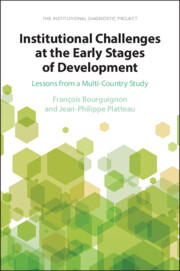Book contents
- Institutional Challenges at the Early Stages of Development
- The Institutional Diagnostic Project
- Institutional Challenges at the Early Stages of Development
- Copyright page
- Contents
- Figures
- Tables
- Abbreviations
- Introduction
- Part I Approaching Institutional Change: Theory and Methodology
- Part II Lessons from Country Case Studies
- Part III Institutional Obstacles to Structural Transformation
- References
- Index
- References
References
Published online by Cambridge University Press: 09 November 2023
- Institutional Challenges at the Early Stages of Development
- The Institutional Diagnostic Project
- Institutional Challenges at the Early Stages of Development
- Copyright page
- Contents
- Figures
- Tables
- Abbreviations
- Introduction
- Part I Approaching Institutional Change: Theory and Methodology
- Part II Lessons from Country Case Studies
- Part III Institutional Obstacles to Structural Transformation
- References
- Index
- References
Summary
- Type
- Chapter
- Information
- Institutional Challenges at the Early Stages of DevelopmentLessons from a Multi-Country Study, pp. 323 - 340Publisher: Cambridge University PressPrint publication year: 2023
- Creative Commons
- This content is Open Access and distributed under the terms of the Creative Commons Attribution licence CC-BY-NC-ND 4.0 https://creativecommons.org/cclicenses/



